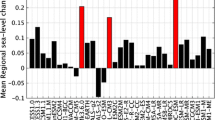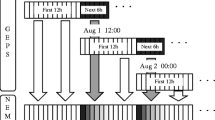Abstract
Two sets of 62-year (1948–2009) and 21-year (1989–2009) high-resolution hindcasts of the meteorological sea level component have been developed for Southern Europe using the Regional Ocean Model System (ROMS) of Rutgers University. These new databases, named GOS 1.1 and GOS 2.1, are a valuable tool for a wide variety of studies, such as those related to a better understanding of sea level variability, flooding risk and coastal engineering studies. The model domain encloses Southern Europe, including the Mediterranean Sea and the Atlantic coast, with a horizontal resolution of 1/8° (~14 km). In order to study the effect of the atmospheric forcing resolution, ROMS is driven with two different regional atmospheric forcings: SeaWind I (30 km of horizontal resolution) and SeaWind II (15 km of horizontal resolution). Both are the result of a dynamical downscaling from global atmospheric reanalysis: NCEP global reanalysis and ERA-Interim global reanalysis, respectively. As a result, two surge data sets are obtained: GOS 1.1 (forced with SeaWind I) and GOS 2.1 (forced with SeaWind II). Surge elevations calculated by ROMS are compared with in situ measurements from tide gauges in coastal areas and with open ocean satellite observations. The validation procedure, testing outcomes from GOS 1.1 and GOS 2.1 against observations, shows the capability of the model to simulate accurately the sea level variation induced by the meteorological forcing. A description of the surge in terms of seasonality and long term trends is also made. The climate variability analysis reveals clear seasonal patterns in the Mediterranean Sea basins. A long-term negative trend for the period 1948–2009 is found, whilst positive trends are computed for the last 20 years (GOS 2.1).












Similar content being viewed by others
References
Backhaus JO (1985) A three-dimensional model for the simulation of shelf sea dynamics. Deutsche Hydrographische Zeitschrift 38:165–187. doi:10.1007/BF02328975
Bernier NB, Thompson KR (2006) Predicting the frequency of storm surges and extreme sea levels in the northwest Atlantic. J Geophys Res 111:C10009. doi:10.1029/2005JC003168
Brown JM, Souza AJ, Wolf J (2010) An 11-year validation of wave-surge modelling in the Irish Sea, using a nested POLCOMS–WAM modelling system. Ocean Model 33:118–128. doi:10.1016/j.ocemod.2009.12.006
Butler A, Heffernan JE, Tawn JA et al (2007) Extreme value analysis of decadal variations in storm surge elevations. J Mar Syst 67:189–200. doi:10.1016/j.jmarsys.2006.10.006
Calafat FM, Gomis D (2009) Reconstruction of Mediterranean sea level fields for the period 1945–2000. Global Planet Change 66:225–234. doi:10.1016/j.gloplacha.2008.12.015
Carrère L (2003) Modeling the barotropic response of the global ocean to atmospheric wind and pressure forcing—comparisons with observations. Geophys Res Lett 30:1275. doi:10.1029/2002GL016473
Carretero JC, Alvarez Fanjul E, Gómez Lahoz M et al (2000) Ocean forecasting in narrow shelf seas: application to the Spanish coasts. Coast Eng 41:269–293. doi:10.1016/S0378-3839(00)00035-1
Dee DP, Uppala SM, Simmons AJ et al (2011) The ERA-Interim reanalysis: configuration and performance of the data assimilation system. Q J R Meteorol Soc 137:553–597. doi:10.1002/qj.828
Ferrarin C, Roland A, Bajo M, Umgiesser G, Cucco A, Davolio S, Drofa O (2013) Tide-surge-wave modelling and forecasting in the Mediterranean Sea with focus on the Italian coast. Ocean Model 61(2):38–48. doi:10.1016/j.ocemod.2012.10.003
Flather R, Williams J (2000) Climate change effects on storm surges: methodologies and results. ECLAT-2 Workshop 66–78
Flather RA, Smith JA, Richards JD et al (1998) Direct estimates of extreme storm surge elevations from a 40-year numerical model simulation and from observations. Glob Atmos Ocean Syst 6:165–176
García-Lafuente J, Del Río J, Alvarez Fanjul E, et al (2004) Some aspects of the seasonal sea level variations around Spain. J Geophys Res 109. doi:10.1029/2003JC002070
Gomis D, Ruiz S, Sotillo MG et al (2008) Low frequency Mediterranean sea level variability: the contribution of atmospheric pressure and wind. Global Planet Change 63:215–229. doi:10.1016/j.gloplacha.2008.06.005
Haidvogel DB, Arango HG, Hedstrom K et al (2000) Model evaluation experiments in the North Atlantic Basin: simulations in nonlinear terrain-following coordinates. Dyn Atmos Oceans 32:239–281. doi:10.1016/S0377-0265(00)00049-X
Haidvogel DB, Arango H, Budgell WP et al (2008) Ocean forecasting in terrain-following coordinates: formulation and skill assessment of the regional Ocean modeling system. J Comput Phys 227:3595–3624. doi:10.1016/j.jcp.2007.06.016
Jacob D, Podzun R (1997) Sensitivity studies with the regional climate model REMO. Meteorol Atmos Phys 63:119–129. doi:10.1007/BF01025368
Jones EJ, Davies AM (2006) Application of a finite element model (TELEMAC) to computing the wind induced response of the Irish Sea. Cont Shelf Res 26:1519–1541. doi:10.1016/j.csr.2006.03.013
Jordà G, Gomis D, Álvarez-Fanjul E, Somot S (2012) Atmospheric contribution to Mediterranean and nearby Atlantic sea level variability under different climate change scenarios. Global Planet Change 80–81:198–214. doi:10.1016/j.gloplacha.2011.10.013
Kalnay E, Kanamitsu M, Kistler R et al (1996) The NCEP/NCAR 40-year reanalysis project. Bull Am Meteorol Soc 77:437–471. doi:10.1175/1520-0477(1996)077<0437:TNYRP>2.0.CO;2
Lionello P (2012) The climate of the Mediterranean region from the past to the future, 1 st Edition 592
Losada IJ, Reguero BG, Méndez FJ, Castanedo S, Abascal AJ, Mínguez R (2013) Long-term changes in sea-level components in Latin America and the Caribbean. Global Planet Change 104:34–50
Lowe JA, Gregory JM, Flather RA (2001) Changes in the occurrence of storm surges around the United Kingdom under a future climate scenario using a dynamic storm surge model driven by the Hadley Centre climate models. Clim Dyn 18:179–188. doi:10.1007/s003820100163
Marcos M, Tsimplis MN (2007) Variations of the seasonal sea level cycle in southern Europe. J Geophys Res 112:2007
Marcos M, Tsimplis MN, Shaw AGP (2009) Sea level extremes in southern Europe. J Geophys Res 114:1–16. doi:10.1029/2008JC004912
Menéndez M, García-Díez M, Fita L et al (2013) High-resolution sea wind hindcasts over the Mediterranean area. Clim Dyn. doi:10.1007/s00382-013-1912-8
Pascual A, Marcos M, Gomis D (2008) Comparing the sea level response to pressure and wind forcing of two barotropic models: validation with tide gauge and altimetry data. J Geophys Res 113:C07011. doi:10.1029/2007JC004459
Pawlowicz R, Beardsley B, Lentz S (2002) Classical tidal harmonic analysis including error estimates in MATLAB using T_TIDE. Comput Geosci 28:929–937. doi:10.1016/S0098-3004(02)00013-4
Ratsimandresy AW, Sotillo MG, Carretero Albiach JC et al (2008) A 44-year high-resolution ocean and atmospheric hindcast for the Mediterranean Basin developed within the HIPOCAS Project. Coast Eng 55:827–842. doi:10.1016/j.coastaleng.2008.02.025
Ray R (1999) A global Ocean tide model from TOPEX/Poseidon altimetry: GOT99.2. NASA Techincal Memo 1999–209478
Sebastião P, Guedes Soares C, Alvarez E (2008) 44 years hindcast of sea level in the Atlantic coast of Europe. Coast Eng 55:843–848. doi:10.1016/j.coastaleng.2008.02.022
Šepić J, Vilibić I, Strelec Mahović N (2012) Northern Adriatic meteorological tsunamis: observations, link to the atmosphere, and predictability. J Geophys Res 117(C2):C02002. doi:10.1029/2011JC007608
Shchepetkin AF, Mcwilliams JC (2005) The regional oceanic modeling system (ROMS): a split-explicit, free-surface, topography-following-coordinate oceanic model. Ocean Model 9:347–404. doi:10.1016/j.ocemod.2004.08.002
Skamarock WC, Klemp JB, Dudhia J et al (2008) A description of the advanced research WRF version 3. In: NCAR Technology, NCAR/TN- 475+ STR
Smith WH, Sandwell DT (1997) Global Sea floor topography from satellite altimetry and ship depth soundings. Science 277:1956–1962. doi:10.1126/science.277.5334.1956
Tsimplis MN, Baker TF (2000) Sea level drop in the Mediterranean Sea: an indicator of deep water salinity and temperature changes? Geophys Res Lett 27:1731–1734
Tsimplis MN, Alvarez-Fanjul E, Gomis D et al (2005) Mediterranean Sea level trends: atmospheric pressure and wind contribution. Geophys Res Lett 32:L20602. doi:10.1029/2005GL023867
Volkov DL, Larnicol G, Dorandeu J (2007) Improving the quality of satellite altimetry data over continental shelves. J Geophys Res 112:C06020. doi:10.1029/2006JC003765
Wakelin S, Proctor R (2002) The impact of meteorology on modelling storm surges in the Adriatic Sea. Global Planet Change 34:97–119
Wang S, McGrath R, Hanafin J et al (2008) The impact of climate change on storm surges over Irish waters. Ocean Model 25:83–94. doi:10.1016/j.ocemod.2008.06.009
Woth K, Weisse R, Storch H (2005) Climate change and North Sea storm surge extremes: an ensemble study of storm surge extremes expected in a changed climate projected by four different regional climate models. Ocean Dyn 56:3–15. doi:10.1007/s10236-005-0024-3
Acknowledgments
The authors would like to thank Puertos del Estado for the REDMAR network’s data provided for this study, as well as the University of Hawaii Sea Level Center, Système d’Observation du Niveau des Eaux Littorales and Istituto Superiore per la Protezione e la Ricerca Ambientale. The satellite data were produced by Ssalto/Duacs and distributed by Aviso, with support from Cnes. This work was partly funded by the Projects iMar21 (CTM2010-15009) and SaltyCor (BIA2011-29031-C02-00) from the Spanish government, and from the FP7 European Projects CoCoNet (287844) and Theseus (ENV.2009-1, n244104). GOS 1.1 and GOS 2.1 data sets are available under request for scientific purposes.
Author information
Authors and Affiliations
Corresponding author
Rights and permissions
About this article
Cite this article
Cid, A., Castanedo, S., Abascal, A.J. et al. A high resolution hindcast of the meteorological sea level component for Southern Europe: the GOS dataset. Clim Dyn 43, 2167–2184 (2014). https://doi.org/10.1007/s00382-013-2041-0
Received:
Accepted:
Published:
Issue Date:
DOI: https://doi.org/10.1007/s00382-013-2041-0




